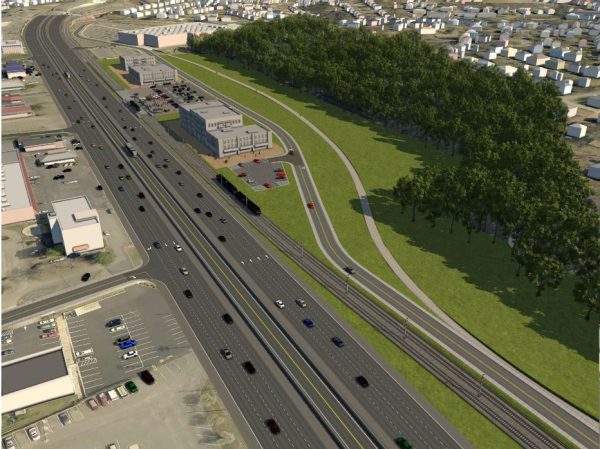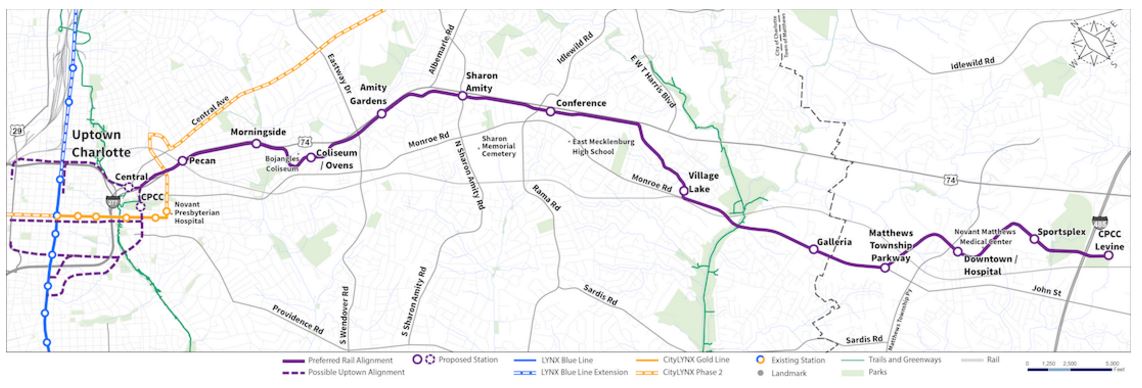Is end near for Independence Blvd. transit debate?

A years-long debate over where to locate the county’s still-unfunded southeast transit corridor – the Silver Line – may be ending this month. But even as that long debate over whether Independence Boulevard is the right route appears likely to be put to bed, this issue still looms: There is no money to build the Silver Line.
The Metropolitan Transit Commission, the governing body for the Charlotte Area Transit System, is expected to vote Oct. 26 on a Silver Line light rail route from the Interstate 277 uptown loop to Central Piedmont Community College’s Levine Campus in Matthews. The proposed alignment runs generally beside Independence Boulevard before cutting over to Monroe Road and then wending through Matthews almost to the Union County line.
David McDonald, a transit planning manager for the Charlotte Area Transit System, briefed the Charlotte City Council’s Transportation and Planning Committee on Monday about the recommended route. Afterward, City Council member Greg Phipps asked, drawing chuckles from the audience, “What funding sources have we identified?”
“This is an alignment that is unfunded,” McDonald said. He said the study’s goal has been to reach consensus on the alignment, offering certainty as CATS looks for funding.
The half-cent transit sales tax, enacted in 1998 with the idea to build five transit corridors by 2025, isn’t bringing in enough money to build anything after the Blue Line Extension light rail, due to open in August 2017.
Debate about the Silver Line – bus v. light rail, Independence Boulevard v. another route – has lasted almost 20 years.
THE FIRST PLAN: BUSES
The initial transit plan done before the 1998 tax referendum called for bus rapid transit for the southeast corridor, now dubbed the Silver Line.* Bus rapid transit, known as BRT, uses buses on a dedicated lane to avoid traffic congestion and is typically less expensive to build than light rail. (The 1998 plan also proposed BRT for what’s now the Blue Line Extension and for what it called the Airport Corridor, which remains unfunded.)
In 2002, a new CATS plan continued to recommend BRT on the Silver Line but added a streetcar from west Charlotte through east Charlotte, running along Beatties Ford Road through uptown and out Central Avenue to Eastland Mall.
Unlike the Silver Line and the west corridor, the streetcar is moving forward. When it became clear in the depths of the economic downturn that the transit tax revenue couldn’t build out the plan, the Charlotte City Council decided to use city funds and federal transit grants to start building the streetcar. The first phase opened in 2015, renamed the CityLynx Gold Line. The second phase is funded and due to open in late 2019. A later, unfunded phase would add a spur to the airport.
Throughout the past 15 years transit planners, elected officials and residents of east and southeast Charlotte disagreed over whether the Silver Line should be bus rapid transit or light rail and whether a light rail project, if one was chosen, should run in the middle of Independence Boulevard or find another route.
The conundrum is that Independence Boulevard, U.S. 74, is not conducive to the kind of walkable neighborhoods in which light rail transit works best. It’s plagued by congestion, carrying more than 100,000 vehicles daily in some spots. It’s notorious throughout the region for ugly strip development, fading shopping centers with massive surface parking lots, and massive traffic problems exacerbated by traffic lights and drivers turning into the numerous car lots, big box stores and shopping centers. The section nearest uptown Charlotte has been converted to a freeway-style highway, and the state plans to extend the freeway eastward. And it’s tough to build an attractive walkable neighborhood alongside a freeway. (See “Another Independence Boulevard: Lost opportunity or potential future?)
BUS V. RAIL: DISCRIMINATION?
Adding to the debate about the route is this: As early as 2002 East Charlotte residents and some elected officials balked at the idea of bus transit for the corridor. “Equal Infrastructure for All Corridors” read a sign at a public hearing in October 2002. West and East Charlotte neighborhoods formed a coalition to protest what their petition called “unequal distribution of tax revenue.” The petition added, “It is an affront to be treated as second class citizens.”
Nevertheless, the 2030 Transit Plan, adopted in 2006, called for BRT on the southeast corridor. However, it hedged its language, saying light rail would also be evaluated.
In 2011 a national study panel of the Urban Land Institute concluded that putting light rail stations in the center of Independence Boulevard would kill any chances for transit-oriented development.
The ULI study recommended expanding bus service along Independence using a dedicated lane as part of the ongoing lane expansion project, and finding a better path for the light rail, such as Monroe Road.
Later in 2011 the MTC scrapped the idea of transit – whether BRT or light rail – down the middle of Independence and told CATS to look at options for rail in the corridor and for improved bus service. The current study began in 2015.
NEW PROPOSAL USES INDEPENDENCE AND MONROE ROAD
The latest proposal from CATS blends an Independence route with a Monroe Road route. It shows a light rail track running beside Independence Boulevard until about Village Lake Drive, where it shoots south to Monroe Road. From there it follows Monroe to Matthews, using Sam Newell Road, Independence Pointe Parkway and other routes to connect to downtown Matthews, the Mecklenburg County Sportsplex and end at CPCC’s Levine campus on the east side of I 485.
In addition, McDonald told the council, the Silver Line plan makes recommendations for expanded bus service, including more express buses using the to-be-built express lane in the center of the highway, and enhanced service on Central Avenue and Albemarle Road.
With no funding for the light rail, it looks as if the enhanced bus service, using the express lanes down the center of Independence, will be the first transit to get moving on the southeast corridor.
Just as that 1998 plan proposed.
* The early colors assigned to the CATS transit routes appear to have been drawn from Boston’s MBTA system. CATS’ first CEO, Ron Tober, worked in Boston early in his career. In Boston, commuter rail lines are shown in purple, subway/light rail lines are green, blue and orange, and the city’s BRT line is silver. In Charlotte, the commuter rail line proposed for north Mecklenburg was originally shown in purple on CATS maps but it became the “Red Line” in honor of the Davidson College Wildcats. Charlotte’s Silver Line color remains, despite the proposed switch from BRT to light rail.
Proposed route for Silver Line light rail. For a larger view, click the image or click here.
